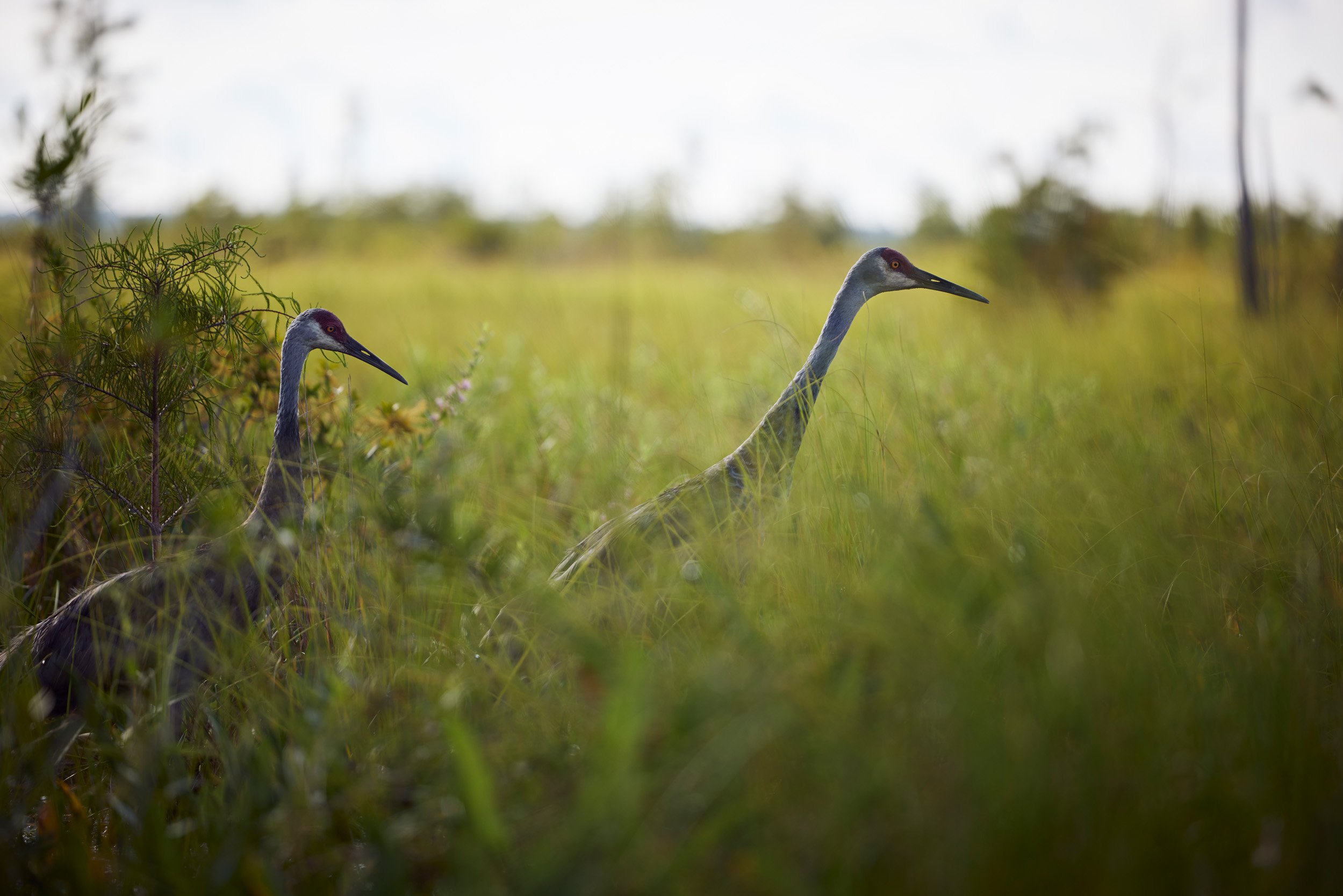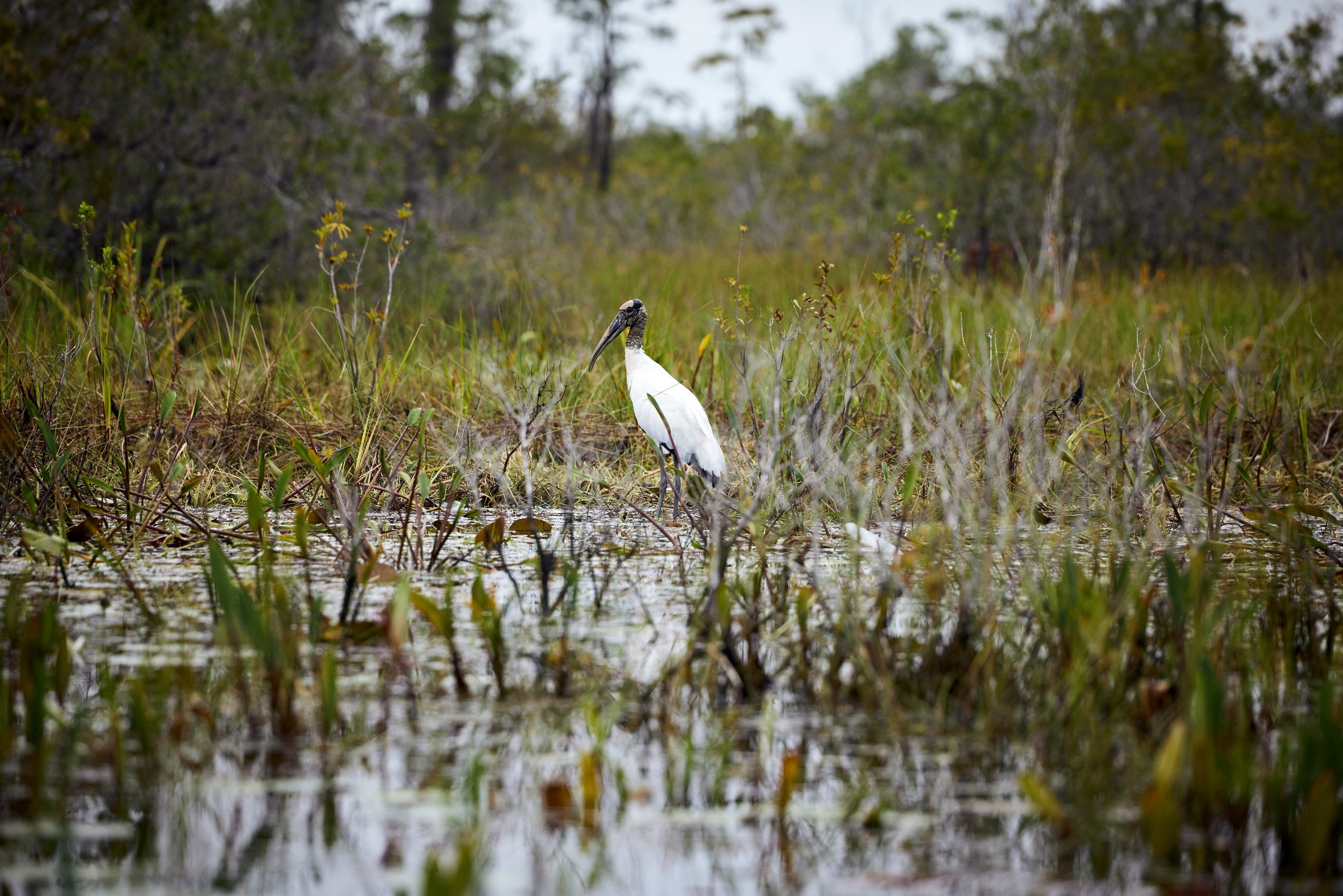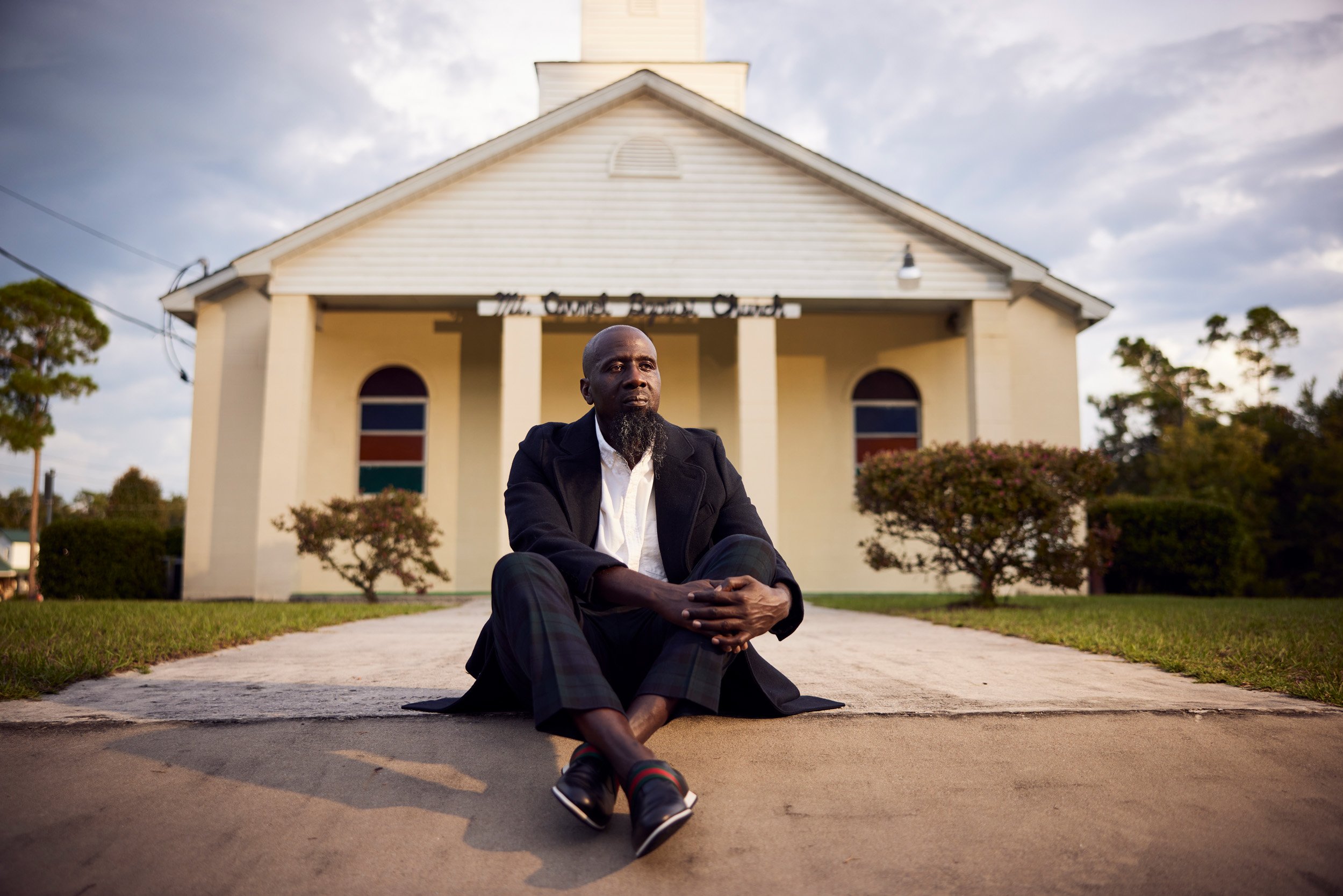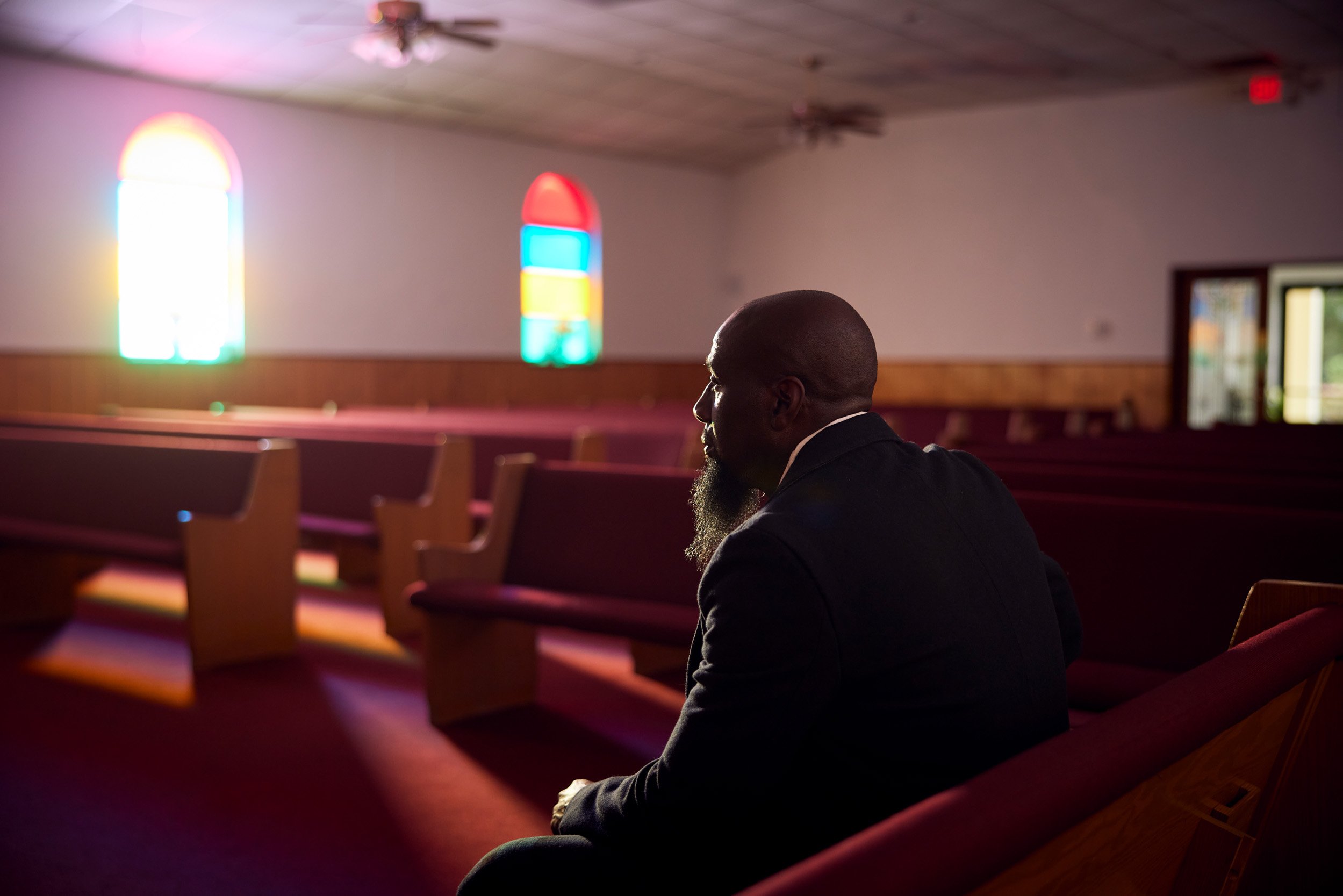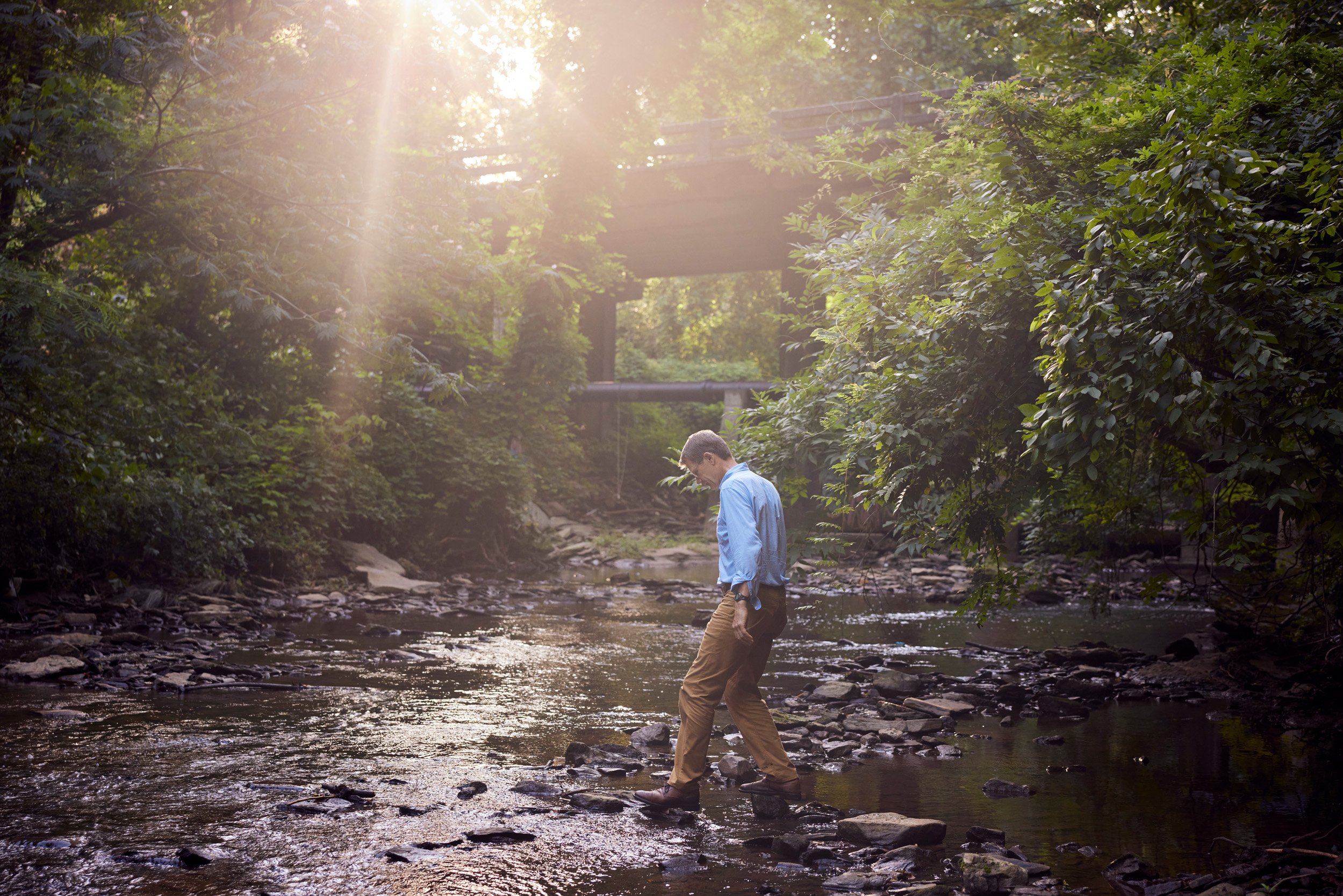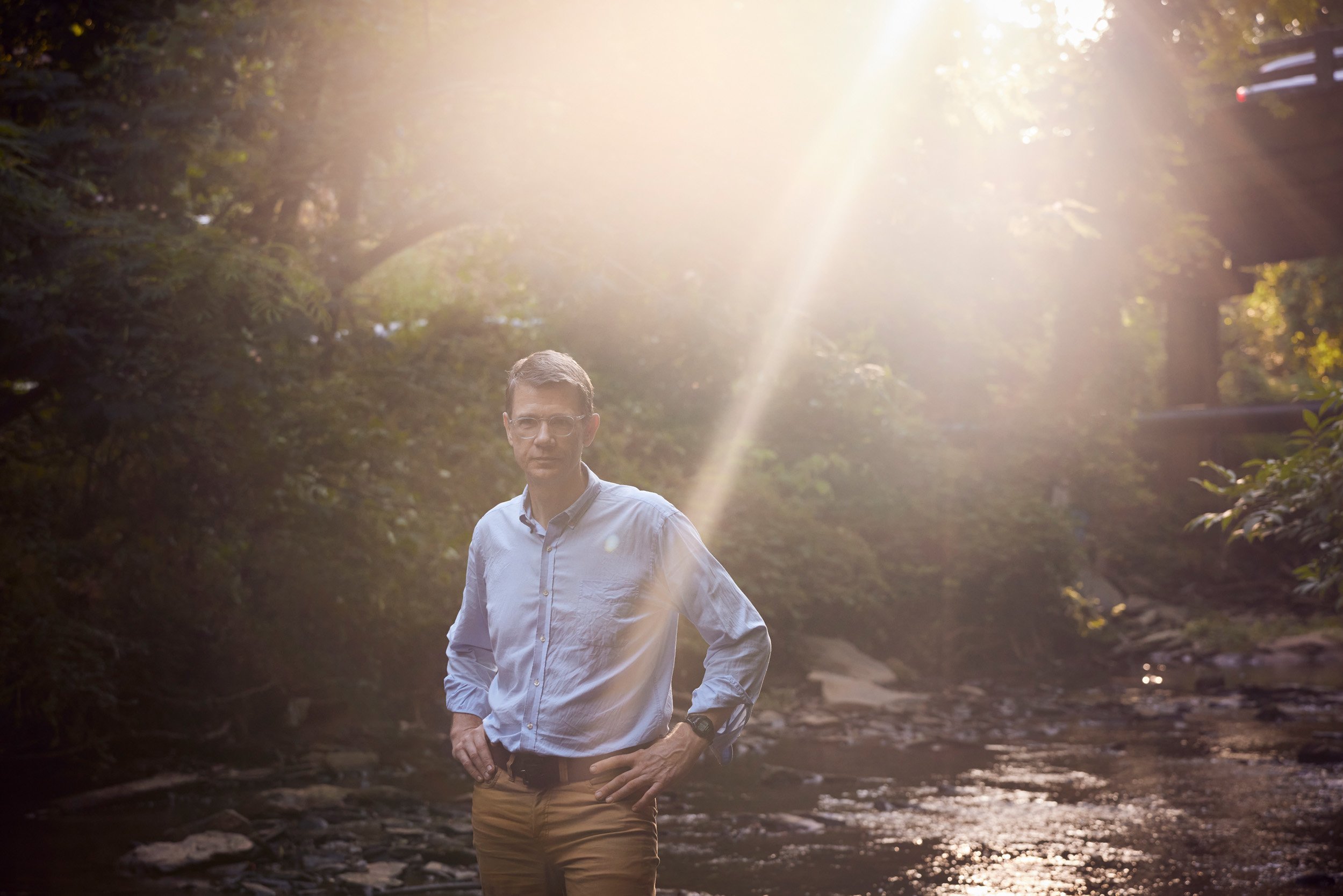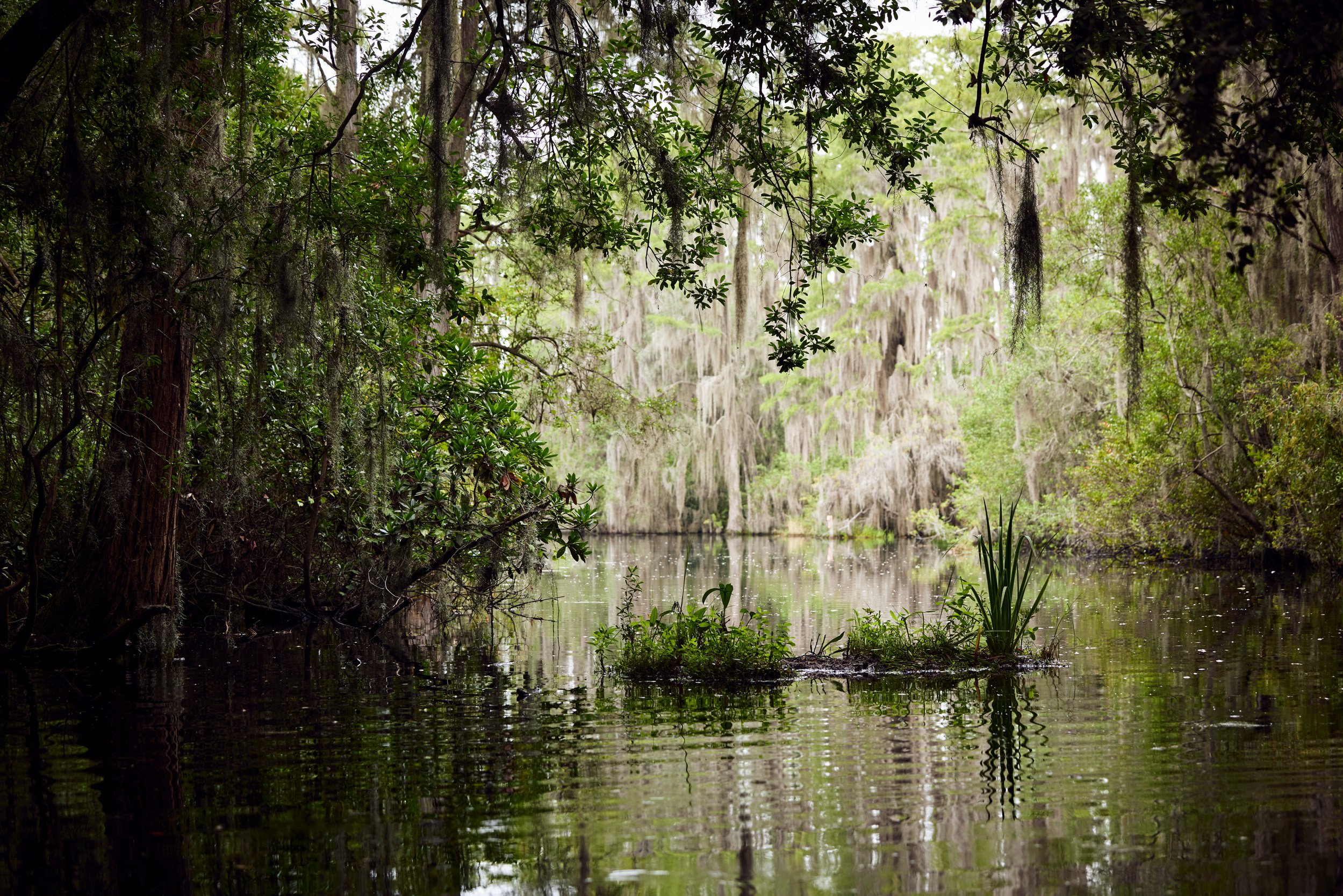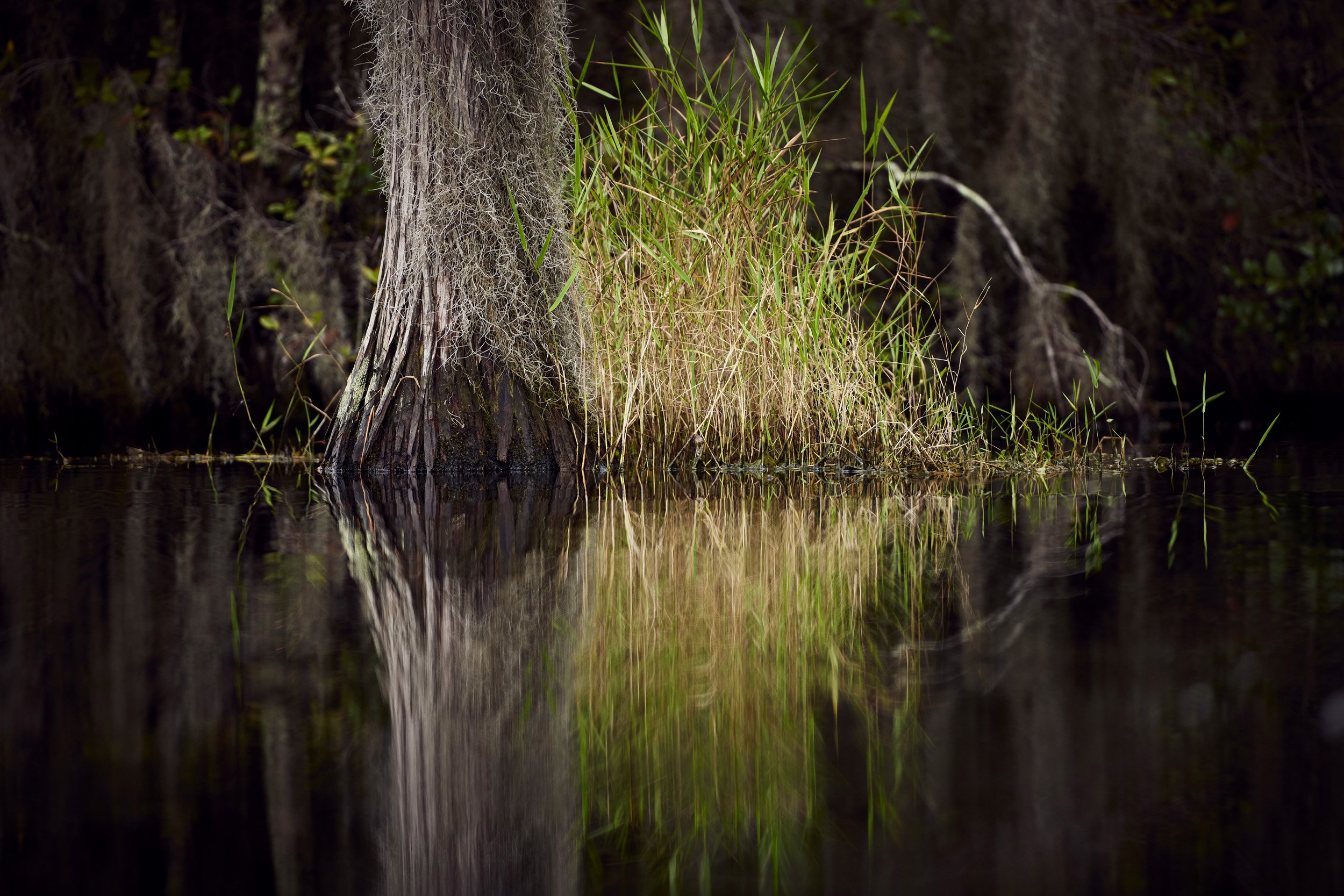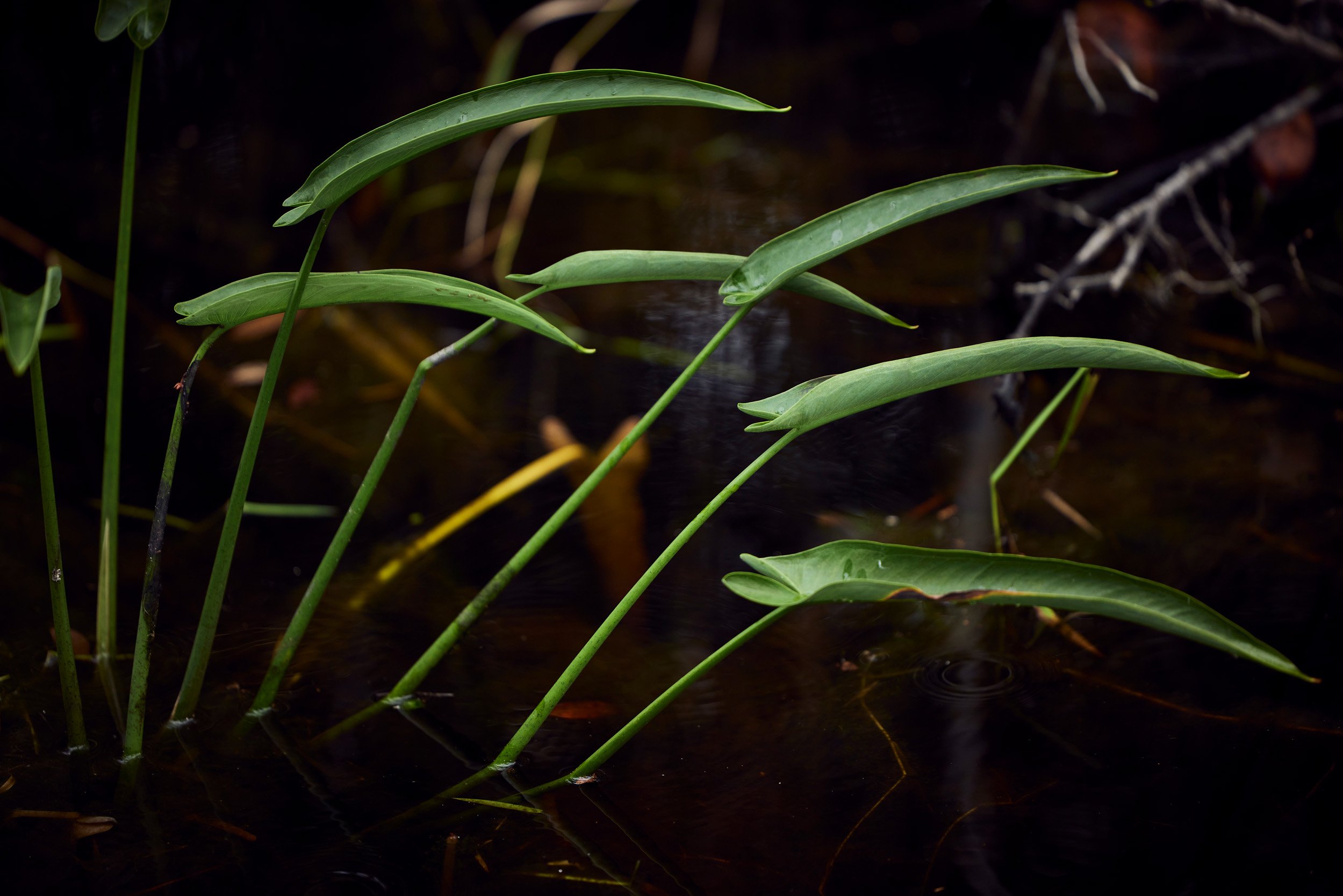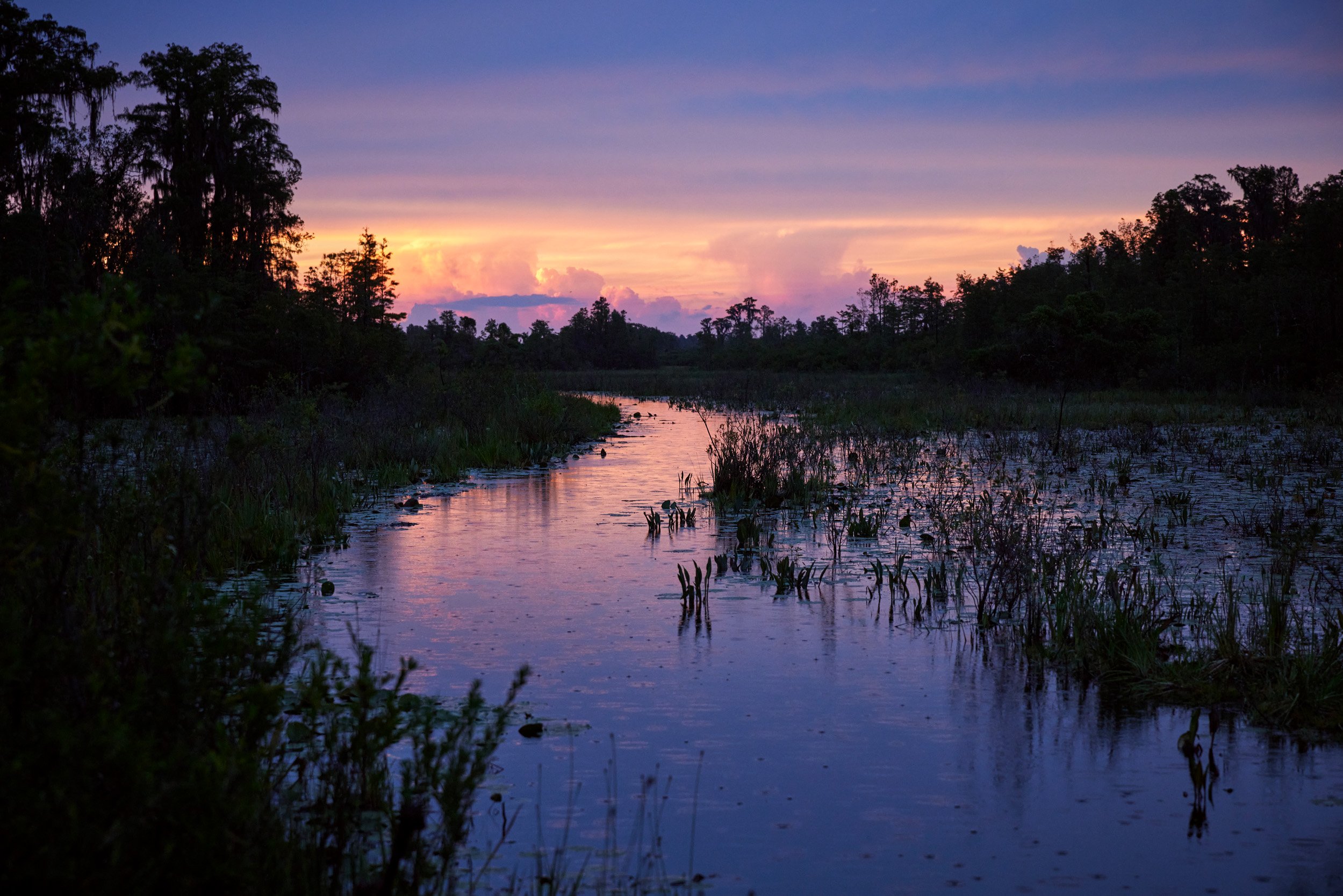Words by Janisse Ray | Photos by Gregory Miller
September 21, 2022
When in early 2019 I caught rumblings that a company wanted to mine on the doorstep of the Okefenokee Swamp, I pretended not to hear.
Having to fight all the time to protect things you love will wear a person out. It will take years off your life. And I was given the burden of loving a place that people are always chasing. This place is always running, fleeing down a dirt road as fast as she can go, scared out of her mind.
They want her trees, they want her fertile soil, they want her deer. They want her golden coast, they want her rivers.
If you don’t know the Okefenokee, it’s a gigantic, ethereal, god-touched swamp in southeast Georgia that’s like no other place on earth. It’s a world wonder — nearly 700 square miles of labyrinthine wildness, the largest blackwater swamp in North America and the largest wilderness area in the eastern U.S. This wild botanical garden serves as a haven for alligators and black bears, woodpeckers and ibises, bitterns and cranes.
The Okefenokee once lay underneath the Atlantic Ocean. Swirling currents formed humps of land, which are now islands (hardwood hammocks) in the swamp. After the ocean receded, rainwater dissolved a limestone bedrock, leaving a large depression. This bowl in the earth was lined with an impermeable layer of clay, which began to hold water.
The company I’m talking about doesn’t actually want the swamp. It wants the titanium dioxide below it, a white mineral used in manufacturing. To the east of the swamp runs a 130-mile spine of barrier island that existed when the ocean was higher, during the Pleistocene. This is called Trail Ridge. Sometimes people refer to it as a terrace, but often the spine of Trail Ridge is level with its surroundings. Hundreds of acres of Trail Ridge are wetlands.
Here titanium dioxide can be found, deep underneath Trail Ridge, in an ancient sand dune. Within Trail Ridge itself are natural clay layers that form basins, and the swamp communicates with the wetlands and basins of Trail Ridge via numerous streams.
Nearly 700 square miles of labyrinthine wildness, the Okefenokee is the largest blackwater swamp in North America. It’s also the surreally beautiful home of countless creatures including herons and bitterns, barred owls and black bears, alligators and ibises.
I was born in the coastal plains of Georgia, near the swamp. I became an environmentalist, then a nature writer. Most of my life I’ve spent championing the glorious but beleaguered landscapes of my native territory.
I first visited the swamp when I was a kid, on a school field trip. I’ve paddled it many times since then. I’ve crossed it twice by kayak — 31 miles east to west of bellowing alligators, titanium-white waterlilies, and wading birds. If anything will knock you to your knees, it’s the gray and scarlet perfection of sandhill cranes. Once I went in with ecologist and Executive Director of the Coastal Plains Institute Bruce Means — my most memorable visit to date. Means had us crawling in tunnels made by bears through titi and fetterbush. He knew where to find the nest of the round-tailed water rat, which lives on a grass platform above the water, under a grass roof. He identified prothonotary warblers flying like the moons of Jupiter above the obsidian channels.
No matter what I am doing, some part of my mind is wandering in the Okefenokee.
The tranquil waters of the Okefenokee are under threat from an Alabama company’s bid to help sate the country’s appetite for titanium dioxide, a mineral used in paint, chewing gum, toothpaste, cosmetics, and countless other products. Just the first phase of the project would obliterate 600 acres.
Twin Pines, a mining company out of Alabama, is the one that wants to destroy hundreds of acres of wetlands next to the Okefenokee for titanium dioxide. Just the first phase of its project would obliterate 600 acres. Twin Pines will tell you the U.S. needs titanium for military smoke grenades and for solar panels, but mostly the mineral goes into paint; it’s sold in pigments labeled “brilliant white” or “the whitest white.” It’s also used for whiteness and opacity in toothpaste, sunscreen, cosmetics, food coloring, plastics, and paper. We bring it home from the supermarket in ice cream, candy, creamers, marshmallows, pastries, cake spreads, dressings, and chewing gum.
A league of Georgians, me included, fought this very fight back in the late 1990s. Then, it was DuPont that wanted the titanium. That campaign almost three decades ago meant a bunch of meetings, letters, a film, establishment of an ecotourism association, promises, and more promises. We Georgians protested DuPont’s plans until DuPont retired its mineral rights and donated 16,000 acres planned for its mine to the refuge.
That saved the Okefenokee for a time, but it didn’t change the economic outlook. The counties touching the swamp are still drowning in poverty. Why is it that the most resource-rich places are the poorest?
Here is a disadvantaged, rural place, and a corporation sweeps in promising jobs. Trees will get cut. Wetlands will be drained. Great growly machines will dig far down into the earth, grabbing bucketfuls of white sand that used to be the bottom of the ocean and filling dump trucks with it. The pit will widen and deepen. Mining will rip apart and destroy the clay layers and water-filled basins of Trail Ridge, as well as end the centuries-long conversation between the Okefenokee and its surrounding wetlands.
As long as Trail Ridge is not permanently protected, as long as people want white paint and white toothpaste and white sunscreen and white doughnuts, the Okefenokee will be at risk.
But the promise of prosperity, however vague or uncertain it might be, is what ultimately moved the county commissioners of Charlton, a county abutting the swamp, to sign a resolution in favor of the Twin Pines mine. I spoke with Jesse Crews, a retired high school basketball coach and longtime commissioner from St. George, Georgia, who represents the district where the mining would happen. Rather, I tried. “I’m not going to speak on that,” he said.
“I want to speak with someone in favor of the mine,” I said. “I need to understand that position.”
“The county is not in support of anything,” Crews said. “We never said we were in support of the mine. We said we were in support of the mine company seeking the permits it needs.”
I tried to press him, but he said I was asking too many questions, and he hung up.
Later that afternoon, county administrator Hampton Raulerson forwarded me a copy of the resolution. It details how the mine would bring in 150 jobs and yearly tax revenue, resulting in economic development beneficial to the county and allowing Charlton to increase the levels of services it provides. In response, the Board of Commissioners “hereby proclaims and expresses support of Twin Pines Minerals’, LLC, proposed heavy mineral sand mining.”
“I would think that any business bringing that many jobs would mean economic development,” Raulerson told me, “in terms of people moving into the area, more homeowners using businesses in the area, more children in the schools.”
Yet, on the street, nobody in Folkston, the county seat of Charlton, speaks up in favor of the mine. “I haven’t run into anyone who will stand on a hill and be for it,” Raulerson said.
“Why?” I asked.
“I don’t know why,” he said.
Folkston, Georgia — a town whose beating heart might as well be the Okefenokee — might benefit economically from the mine, but local support seems tepid. “I haven’t run into anyone who will stand on a hill and be for it,” one county administrator said of the proposed Twin Pines mine.
I think I know why. The people of Okefenokee are in a double bind. They want good jobs, but they love the swamp. They’re proud of it. They love fishing in it. Their people lived in it before it became a wildlife refuge. It’s their home. They’re swamp people.
I spoke with the Rev. Antwon Nixon at length about this. Born and raised in Folkston in the ’80s, he visited the swamp many times as a child. Alligators especially thrilled him. “So when I found out what was going on with the mine,” he said, “I was very passionate about it.”
Rev. Nixon knows what it’s like to live in a place where jobs are scarce. Nixon is a kind-eyed man in his 40s with a manicured beard. He pastors at Mt. Carmel Baptist, although by trade he’s an electrician, and to secure a decent income for his family, he drives to Jacksonville to work, 50 miles each way, leaving home at 3:30 a.m. “I know plenty of people who do that,” he said. “My mom makes that same drive. My dad works at Kings Bay. We’ve been driving out of town as long as I can remember.
“One of the easiest things to do to fool people is to promise them jobs and money, but at what expense are you willing to sell out?” Nixon said. “I mean, that money’s going to run out, but you destroy the swamp. We can never get that back. So you have to have some background [information] and moralism to say no to the money.”
The Rev. Antwon Nixon, born and raised in Folkston, advocates a long-game approach to the swamp he loves: “One of the easiest things to do to fool people is to promise them jobs and money, but at what expense are you willing to sell out? I mean, that money’s going to run out, but you destroy the swamp. We can never get that back.”
This story presents as a classic David and Goliath tale, a large corporation acting as Goliath. The Okefenokee — a swamp, with all the oozing, malarial metaphors of swamplandia, in rural south Georgia, where brain drain is no joke — would seem to be David, a little guy loading his slingshot with a pebble.
But this story is reversed.
Here, the mining company is David, and it has come up against not just a single giant, but one with many heads, a hydra.
First, there’s the swamp itself, a kind of bottomless, endless place, with more than 600 species of wild plants, 200 species of birds, 100 of amphibians and reptiles, 35 of fish, and so on.
Add to that everybody who’s ever paddled through the mercurial, lily-thick waters of this dreamy, glittery place — every schoolkid, every tourist, every traveler to antique lands — people who forever after are haunted by the primeval beauty and mystery. The place imprints on their brains, and for all their lives they who have seen it dream about this fecundity. They dream about its sandhill cranes, alligators, bass, meadows of pitcher plants, towering cypress.
A mining company pales next to a thing that can inhabit your mind like a demon. How bold the miners. They thought they could catch the old swamp sleeping.
Rick Middleton, native of Birmingham, started the Southern Environmental Law Center (SELC) in 1986. An attorney who cared about the environment, he was gobsmacked by how national environmental organizations regularly ignored iconic Southern landscapes like the Appalachian Mountains, the Outer Banks, or the Altamaha Bioreserve.
Now 100 lawyers and a total staff of 200 work in nine offices in six Southern states and in Washington, D.C., sewing the legal suturing to protect Southern nature.
Bill Sapp, a tall, thin, clean-shaven man with piercing eyes, is one of SELC’s senior attorneys. When he heard about Twin Pines’ plan to mine titanium, he was alarmed. He reached out to environmental groups and invited them to the swamp for a meeting. At that event they voted to form a coalition, the Okefenokee Protection Alliance (OPA).
“The coalition has been incredibly successful,” Sapp told me. “Not only in what we’ve been able to accomplish, but also in working together smoothly and tapping into the talents of every group involved.” Forty member organizations boast more than 5 million members.
In the mine permitting processes, Sapp told me, comments poured in from more than 100,000 people. “That is just unheard of. They were from 50 states and 36 countries.”
A senior attorney with the Southern Environmental Law Center, Bill Sapp mustered support to form the Okefenokee Protection Alliance, a formidable coalition of more than 40 organizations (and 5 million members) staying laser-focused on the Twin Pines permitting process.
It was Kelly Moser, a dark-haired woman with warm blue eyes and Sapp’s colleague at SELC, who explained to me how the Trump administration put the Okefenokee at risk.
“The Okefenokee Swamp itself is a pristine wetland,” she said. “But there are wetlands outside the refuge boundaries that are critical to the swamp’s hydrology and health.” Those peripheral wetlands, even on private property, have been consistently protected under the Clean Water Act despite changing administrations or what party finds itself in power.
So when Twin Pines wanted to harvest titanium dioxide from the Okefenokee’s doorstep, they had to ask the Army Corps of Engineers for permission, which they did in 2018. The Army Corps said no, not without a federal Clean Water Act permit — these wetlands fall within the scope of the Act, and they are protected.
In late 2020, however, the Trump administration passed a rule that narrowed the definition of waters with federal Clean Water Act protection. Overnight, millions of miles of streams and millions of acres of wetlands across the country lost protection.
On the very day that the revised rule was published in the Federal Register, Twin Pines returned to the Army Corps and asked for a redo. They hit pay dirt. The Army Corps reversed course, saying it now had no jurisdiction in the matter.
Twin Pines began to position earth-moving equipment on the mining site near the mineral-rich wetlands around the Okefenokee. Then, in this roller coaster of a ride, things changed again, and this past June, the Army Corps halted the mine.
The Biden administration had been tightening environmental regulations and requiring “robust” consideration of Native Americans in federal matters. Deb Haaland, the first Native American cabinet secretary, was heading the Department of the Interior. Sen. Jon Ossoff, a Democrat elected to the Senate in 2021 at the age of 33, had begun lobbying for the swamp, too.
It turns out that the Muscogee (Creek) Nation had not been consulted in the Army Corps’ decision to allow mining. And that was a mistake. The Muscogee (Creek), although now headquartered in Oklahoma, hold deep ties to the southeastern U.S., their place of origin. The proposed Ocmulgee National Park, for example, a project keenly important to the Muscogee (Creek), was the “place where we first sat down.”
RayLynn Butler, citizen of the Nation and its manager for historic and cultural preservation, described long-standing ties between the Nation and the Okefenokee. “We are very active in the protection of sacred lands, cultural sites, in our homelands,” said Butler. Of the swamp, she said, “This is thought to have been one of the most blissful places on earth to the Muscogee people.” The Nation is working on a Traditional Cultural Property designation for the Okefenokee.
Marian McCormick, Principal Chief of the Lower Muscogee Creek, pointed out that the area to be mined contains Native burial grounds: “The Creek Indians and the Muscogee are connected to the land by the bones of our ancestors, and we don’t want them to be disturbed.”
The mine was halted. “We were elated,” Moser said.
An alligator bespeaks the primeval, irreplaceable quality of the Okefenokee. It’s a place replete with life — 200 species of birds, 100 of amphibians and reptiles, 35 of fish — that remains vulnerable to seesawing legal and jurisdictional decisions and changing administrations.
Then Twin Pines sued the Corps to challenge its decision to reinstate protections for the Okefenokee wetlands.
In August, in a quick turn of events, without explanation or justification, the Corps settled the Twin Pines lawsuit. As Moser put it, the Corps rolled over to appease Twin Pines — again without consulting the Muscogee (Creek) Nation — saying only that the federal government wouldn’t stand in the way of the mine based solely on the Corps’ failure to consult with the Muscogee (Creek) Nation.
Now that the Corps has reversed its decision, the Georgia Environmental Protection Division has reinitiated its permitting process. “They’re taking the environmental impacts of the mine seriously,” Moser told me. “If Twin Pines wants to pursue mining at the site, it has to secure four state permits. It has to show that the mine is not going to hurt the swamp, and Twin Pines has not even come close to doing that.”
As well, the mining company must still comply with the Clean Water Act, and if it moves forward without a permit, it opens itself to citizen enforcement.
Now we add to the Goliath fighting for the Okefenokee: the powerhouse of the Southern Environmental Law Center, the OPA coalition, the Muscogee (Creek) Nation, plus at least 100,000 people willing to write letters. That group is gigantic, titanic, colossal. Brobdingnagian. But it’s not even the entire allied forces working to save the Okefenokee.
The Okefenokee’s peripheral wetlands — critical to the swamp’s hydrology and health – have been consistently protected under the federal Clean Water Act. Those protections could be severely curtailed depending on how the U.S. Supreme Court rules in an upcoming case.
When Twin Pines bulldozed into the scene in 2018, a lot of people realized that we need a bigger plan to protect Trail Ridge. The titanium is still down there, and we’re still using toothpaste.
The Okefenokee Swamp deserves permanent protection, which could happen in a number of ways: pass a state law that forbids mining Trail Ridge; put conservation easements on those lands; or make them public lands through purchases.
But there’s another way, and that would be to make the Okefenokee Swamp so iconic, so globally recognized as the jewel it is, and so lucrative that no one would consider anything as destructive as a mine.
In steps Kim Bednarek, a woman with a big plan. She reminds me of a rose pogonia, one of the plants growing at the swamp edge. Maybe that’s because she’s tall and slender, wearing a rose-colored shirt printed with botanicals.
A couple of years ago, Okefenokee Swamp Park (OSP), an attraction near Waycross, hired Bednarek to be its first executive director in more than 50 years. At the time Bednarek was directing a Montessori school in Jacksonville, where she had been wildly successful — huge increases in revenue, increases in student numbers, large construction projects. OSP needed a new vision.
When she first took the job, at the height of the pandemic, Bednarek began a listening tour, as she called it, to understand the needs and potentials of the region.
Soon after she arrived, a concession supplying boat tours, canoe rentals, guides, and merchandise to visitors at the swamp’s Folkston entrance came up for bid. Chip and Joy Campbell had run the concession for two decades, and they were ready to step back. OSP won the bid and bought the Campbells’ business.
Now Bednarek had to think bigger than one park. She had to think of the swamp as a whole.
She and I met at the Folkston entrance, in an air-conditioned room in the visitor center. “I want to hear your vision,” I said.
“It’s not my vision,” she said. “It’s a vision. It’s a vision that invites engagement by stakeholders in a planning process. It can’t belong to a person, a city, or a county. It has to belong to a region.
“We’re in the process of creating something that could be catalytic,” she said. “To repurpose the swamp as a driver for a conservation economy, not as an extractive resource.”
Kim Bednarek was brought in as executive director of Okefenokee Swamp Park a couple of years ago. From that relatively modest beginning, she has begun implementing a holistic vision of the swamp as “a conservation economy, not … an extractive resource.”
It’s a tall order. As Bednarek is quick to admit, the needs in the region are profound. “Right now these communities are in decay, disrepair, and dysfunction,” she said. I asked her to elaborate, although I knew the answer. I live it. There’s poverty, a true lack of resources. There’s little connectivity, no broadband. There’s little (if any) strategic planning; a lack of collaboration. The downtowns are dotted with boarded-up buildings. Covid rates are high. State and national politicians ignore the region because the vote is not there. Atlanta is not paying attention. In real terms this means things like the city of Folkston has no hospital. Folkston is missing a Chamber of Commerce director. Waycross doesn’t have a city manager or a director for its development authority.
“Why was it allowed to get this way?” Bednarek asked, rhetorically.
“You think it was intentional?” I asked.
“Maybe,” she said.
“Why?”
“To take the resources?” She paused. “That’s dark, I know.” To think that a place could be allowed to sink into dysfunction to make it easier to colonize is, I agree, a dark thought, albeit one worth considering.
Bednarek plans to curate a world-class experience at Okefenokee that is both inviting and authentic. It will be called Okefenokee Experience, modeled after the Adirondack Experience, a cultural center that celebrates the nature and culture of the Adirondack Mountains in western New York, and it will bring a new interpretive center, cultural history museum, and dark skies observatory to the tri-county area surrounding the swamp. Bednarek is helping to get the Okefenokee recognized as a UNESCO World Heritage Site.
To that end, Bednarek spends most of the hours of the day casting a vision, catalyzing investment, and building a constituency.
“We’re going to continue to share the vision and message in a way that’s relatable,” she said. “We’re going to get out of the mindset of fear and scarcity and transition to one of abundance. Not competition, but collaboration. The more we collaborate locally, the more our voice becomes one. People who make decisions can hear us. I see a Brevard, an Asheville, a Boulder. Let’s do that.
“The solution isn’t to do the thing you’ve been doing the last 50 years,” she said. “I choose not to stay small.”
There are local people who don’t want their towns to become tourism-driven, another Hilton Head or Fernandina. “We have enough traffic,” one restaurant owner told me. “I love my small town.”
“And what do you think of the mine?” I asked. “What about jobs?” She tells me she’s opposed to the mine and didn’t believe it would create as many jobs as the company promised. Instead, it would do irreversible damage. “The mine’s going to destroy” is what she said.
The hydra-headed Goliath doesn’t rest. Bednarek is working to make the Okefenokee a world-class destination. SELC’s cadre of lawyers is figuring the next move. Petitions are being circulated. People are signing them.
Bednarek’s always-collaborative plans include the Okefenokee Experience, which will bring a new interpretive center, cultural history museum, and dark skies observatory to the tri-county area surrounding the swamp. She’s also helping to get the Okefenokee recognized as a UNESCO World Heritage Site.
Moser is watching a case that the Supreme Court has agreed to hear this fall, Sackett vs. EPA. The EPA, under the aegis of the Clean Water Act, reprimanded the Sackett family for placing fill dirt into wetlands in Bonner County, Idaho, that was not only destroying the wetlands but also polluting nearby Priest Lake. The case is a potential threat not only to the swamp but to waters across the country, because the Supreme Court is weighing in on what waters can and cannot be protected under the Clean Water Act as “waters of the United States.”
“If opponents of clean water in this case get what they are asking for,” Moser said, “it would eliminate long-standing protections that we have enjoyed for the last 50 years and ignore how water bodies like the wetlands adjacent to the Okefenokee affect the health of other water bodies.”
Meanwhile, the climate crisis is putting pressure on water. Some places will suffer more than others. Some places will burn because of lack of it. Others will become deserts. A few will get too much rain, others not enough rain. Georgia and Florida are already feeling the pressures of changing water patterns.
And wetlands — including those at risk from Twin Pines — are the best natural guards against flooding from the increasing number of storms we are seeing in the Southeast with our changing climate.
Permanent protection for the Okefenokee could happen in a number of ways: pass a state law that forbids mining Trail Ridge; put conservation easements on those lands; or make them public lands through purchases.
“I think that probably my role, as I see it developing, is being a key figure to get community involvement,” Rev. Nixon told me in one of our many conversations. “To say, ‘Hey, you know, it’s time for us to stand up for ourselves.’”
Helping people stand up for themselves is the theme of all his work. He quotes Isaiah 9:2, “The people that walked in darkness have seen a great light.” Nixon helps young people in his community get “streamlined.” “We work with them to have a goal, to have a focus, to find something that they can get passionate about, which will ultimately make them better citizens,” he said. He helps people who’ve suffered oppression “transition to a new mindset.” He organizes community days to feed people, pass out backpacks full of school supplies, and preach the Gospel.
One day at lunch break, at his electrician job, Nixon decided to sit under a tree at work and eat his bowl of fruit. There in the shade he heard something. Later his coworkers said, “Man, I saw you sleeping up under that tree.” But he wasn’t sleeping. He was listening to the tree. The tree was God, offering a revelation to Nixon to take his church outside.
“I literally said, ‘Man, this tree is talking to me.’ I mean, He's everywhere and He's speaking to us at all times. I think as human beings we have to stop and pay attention and listen to what He's saying. For me, this movement was so that I could get more involved in what's actually happening in my own neck of the woods and be a voice of the clergy that might overlook this because it's not what we would consider church-related.
“Going outside gave me an opportunity to get outside the confines of the church, as far as what we would call church business, and get into the business of the church, which is whatever God has supposed it to be.”
Once a season Nixon brings his entire church outside, to be closer to nature and to the people, in what he calls Church Outside the Walls. He sets up under a shelter in a park in Folkston. He brings the choir, the drums, the keyboard, the hand fans.
Time will tell whether the Okefenokee will be found to have enough value in itself to prevail over economic inducements and the world’s need for stark-white commodities.
Nixon invited me to Church Outside the Walls on a hot day in July. He had a white T-shirt waiting, depicting flames coming out of a sanctuary. The lettering said “Church on Fye.”
The service was so inspiring, moving, and beautiful that I forgot about the heat. Nixon stayed busy, unloading the drums, greeting people, running off to bring children back in the church van. Then the choir members sang and danced, jubilantly, throwing their arms to the sky. When the preaching started, Nixon called five school-age boys to the front who had just returned from a D.C. trip with him. “They got to walk through the halls of the White House,” he told the congregation, to wild applause. The message of Nixon’s sermon was, “When God co-signs, it’s a wrap. You can book it.”
Here, the Okefenokee’s defenders become even more visible. Church on fire. Lawyers on fire. Sapp on fire. Bednarek on fire. OPA on fire. Ossoff on fire. The Muscogee (Creek) Nation on fire. People on fire.
Of everybody I met, I asked this question: With the swamp threatened, what do we need from people?
The Okefenokee needs you to be “on fire.”
A good way to do that is to visit, to book a trip, to show up at one of the three entrances and buy a ticket for a boat ride. My suggestion: Make a reservation to cross from one side to the other — a good three days of paddling through peat batteries full of wildflowers, sleeping on a platform above tannic water, listening to barred owls and alligators, looking up into the dark sky that sparkles with an unfathomable number of crystalline stars.
You’ll dream as if possessed. You’ll never forget it. You’ll hear the swamp calling that it needs you — you, on fire for this singular, splashy, spirit-filled place.
Janisse Ray is an American writer whose subject most often falls into the borderland of nature and culture. She has published six books of nonfiction and two collections of eco-poetry. Ray has won an American Book Award, Pushcart Prize, Southern Bookseller Awards, Southern Environmental Law Center Writing Awards, and Eisenberg Award, among others. Her first book, Ecology of a Cracker Childhood, was a New York Times Notable. The author has been inducted into the Georgia Writers Hall of Fame. She lives on an organic farm near Reidsville.
Gregory Miller grew up in a small town outside Atlanta and began working as a commercial photographer in 2003, specializing in people on location. He has an enduring respect and love for the outdoors, most recently spending a week backpacking on the East Coast Trail in Newfoundland. In one of his five canoes and kayaks, he has paddled the Toccoa, Chattahoochee, Flint, Ocmulgee, Ogeechee, Altamaha and Suwannee Rivers in Georgia. This assignment for The Bitter Southerner was his fourth visit to the Okefenokee. He’s currently planning a trip on the Northern Forest Canoe Trail, the longest inland water trail in the U.S.




